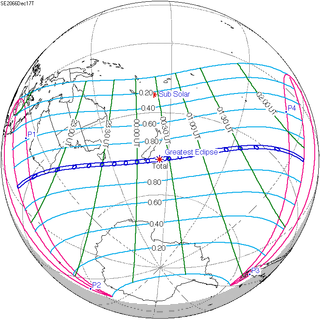| Solar eclipse of December 17, 2066 | |
|---|---|
| Type of eclipse | |
| Nature | Total |
| Gamma | −0.4043 |
| Magnitude | 1.0416 |
| Maximum eclipse | |
| Duration | 194 s (3 min 14 s) |
| Coordinates | 47°24′S 175°48′E / 47.4°S 175.8°E |
| Max. width of band | 152 km (94 mi) |
| Times (UTC) | |
| Greatest eclipse | 0:23:40 |
| References | |
| Saros | 133 (48 of 72) |
| Catalog # (SE5000) | 9657 |
A total solar eclipse will occur at the Moon's ascending node of orbit between Thursday, December 16 and Friday, December 17, 2066,[1] with a magnitude of 1.0416. A solar eclipse occurs when the Moon passes between Earth and the Sun, thereby totally or partly obscuring the image of the Sun for a viewer on Earth. A total solar eclipse occurs when the Moon's apparent diameter is larger than the Sun's, blocking all direct sunlight, turning day into darkness. Totality occurs in a narrow path across Earth's surface, with the partial solar eclipse visible over a surrounding region thousands of kilometres wide. Occurring only about 18.5 hours before perigee (on December 17, 2066, at 19:00 UTC), the Moon's apparent diameter will be larger.[2]
The path of totality will be visible from parts of southwestern Australia and Stewart Island of New Zealand. A partial solar eclipse will also be visible for parts of Indonesia, Australia, Antarctica, and Oceania.
This total eclipse follows a similar path to the eclipse on December 25–26, 2038.
- ^ "December 16–17, 2066 Total Solar Eclipse". timeanddate. Retrieved 19 August 2024.
- ^ "Moon Distances for London, United Kingdom, England". timeanddate. Retrieved 19 August 2024.
